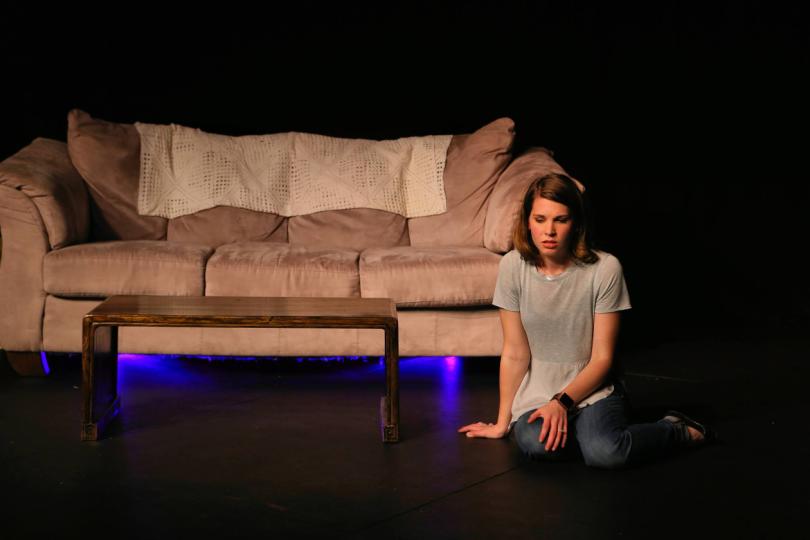Intersections: where mental health and theater come together

Welcome to a new week, friends. Derek’s News & Notes column is one of the very few things I regularly read, so the invitation to take over this week felt pretty rad.
You’re probably well aware of recent events involving old white dirt bag men, and I could extrapolate further, but I’m going to leave that be for the week for the sake of self care.
Speaking of self care...
Let’s talk about mental health. Have you ever seen a therapist? Are you aware of your potential triggers? Is it something you even spend time thinking about?
As someone who was diagnosed with depression and anxiety a few years ago and who regularly attends talk therapy, mental health continually lingers at the forefront of my mind. I recently attended a show during one of my bigger dips of depression, which had been triggered by events from the previous weekend. Little did I know, the topic of suicide would come up in this show as the main character dealt with loss and feelings of despair. And the word “suicide” was used multiple times over.
I felt blind-sided, and after the show I was a wreck.
Where was the trigger warning?
Later, I learned that suicide hotline numbers were posted at the box office, which I vaguely recall seeing. But, dear friends, sometimes people need triggers spelled out for them, and I’ve never truly understood that until now. Share them on your Facebook event page, on your ticket purchase page, in the program, etc.
Coincidentally, the show I had planned to see the next night explicitly stated a suicide trigger warning on the Facebook event page and was even described as a show about mental health. Persistent Theatre Productions’ Alyssa Brooke wrote To Evaporate specifically to enter the conversation about decreasing the stigma of mental illness, and there were talk backs after every show to help people process what they experienced.
Talk about a marked difference.
I waited to see To Evaporate until I felt more mentally prepared to take it on and even chatted online with director Meggie Greivell who graciously provided more details about what happens in the show. While the show still challenged me, at least I understood what I was getting into. And I made sure to book an appointment with my therapist.
It’s not just a white people thing
Broadway has brought us Next to Normal and Dear Evan Hansen whose main characters live with different forms of mental illness. I’ve seen Next to Normal twice locally, and I attended Dear Evan Hansen the day it won big at the Tony Awards. While I commend both shows for making strides in decreasing the stigma of mental health, their whiteness does not escape me. (And don’t even get me started on all of the other problems with Dear Evan Hansen.)
As I delved into the archives of how theater has tackled mental illness in the past, David Rabe’s Good for Otto popped up. This 2015 play that received high praise involves a psychotherapist in a small town in Connecticut and his patients who see him for a variety of reasons. Surprise, Rabe is a white dude. Next to Normal’s writer Brian Yorkey is a white dude. Dear Evan Hansen hails from two white dudes, Benj Pasek and Justin Paul. The original casts of all of these shows are dominated by white people.
Using theater to decrease the stigma will not succeed if it’s only presented through the lens of white people. People of every race, age, and gender live with mental illness, so on-stage inclusivity matters.
Keep working to decrease the stigma
Locally, more and more conversations around mental health are happening which excites me. Both productions of Next to Normal were amazingly powerful, and this summer I attended Fearless Comedy Productions’ Anxiety! The Musical -- I’ll give you two guesses what it’s about. The founders of up and coming Wildwood Theatre include decreasing the stigma as part of their mission. We’re also lucky to have Rachel Petrie here to present Fadeaway Girl next month where she shares anecdotes about her bipolar diagnoses (yes, she’s been diagnosed twice).
These conversations take courage, especially when sharing personal experiences with an audience. Despite feeling scary at times, vulnerability can lead to amazing things when people can relate to the experience of others.
There are many things to consider when producing work that covers this topic, of course. If it’s your own story, by all means, go forth with your commendable bad assery. If it’s anything beyond that, consider why you’re selecting a show that touches on this topic. Does the show reflect your own experience? If not, are you fetishizing mental illness?
Think about who you can include in the production process and in your cast to help honor the content. Do you need to provide some kind of support (i.e. counseling services) for your cast and crew during the rehearsal process? Should you include trigger warnings or provide any resources for your audience (talk backs, hotline information, etc.).
If you’re not presenting a show about mental health, step back and look at the characters in your show. Is one of them a “loony” who’s only there for comic relief? How often do the phrases, “That’s crazy!” or “That’s insane!” get tossed around? Think about how these things can affect someone living with mental illness. As much as we need to talk about mental health, we must do so with awareness.
It’s not perfect; nothing ever is. But there are promising starts to including theater in the conversation around mental health. Even writing this feels pretty therapeutic, so thank you to Derek for opening up this space for me. Be good to yourself this week, practice some self, and thanks for reading.


